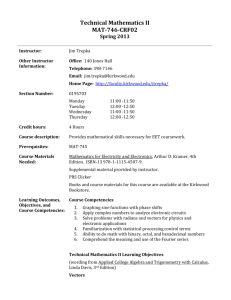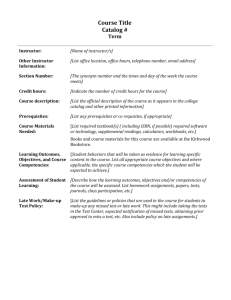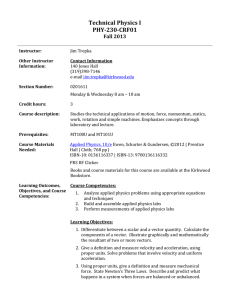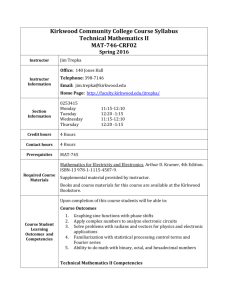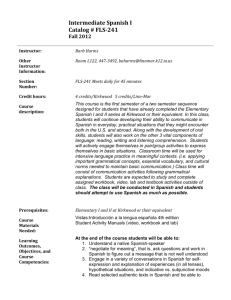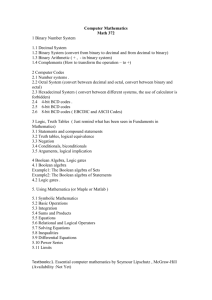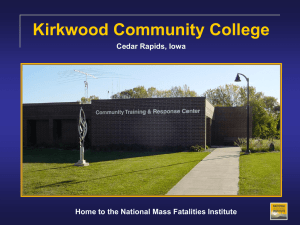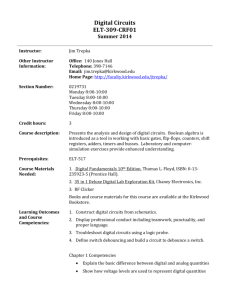Emergency Information - Kirkwood Community College
advertisement
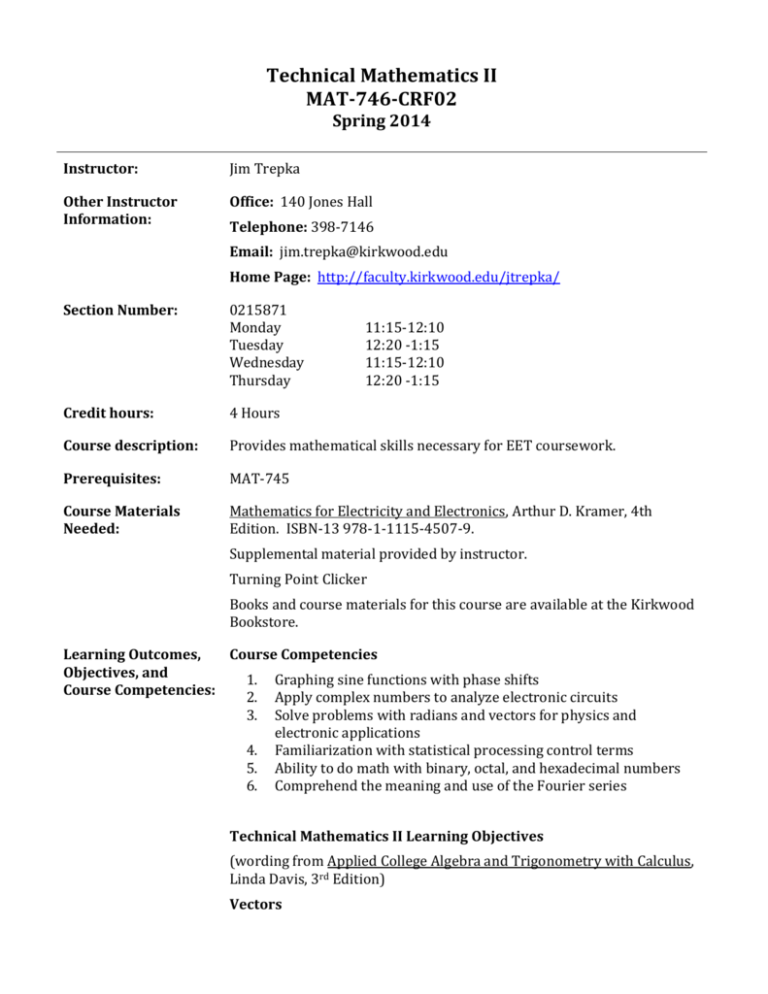
Technical Mathematics II MAT-746-CRF02 Spring 2014 Instructor: Jim Trepka Other Instructor Information: Office: 140 Jones Hall Telephone: 398-7146 Email: jim.trepka@kirkwood.edu Home Page: http://faculty.kirkwood.edu/jtrepka/ Section Number: 0215871 Monday Tuesday Wednesday Thursday 11:15-12:10 12:20 -1:15 11:15-12:10 12:20 -1:15 Credit hours: 4 Hours Course description: Provides mathematical skills necessary for EET coursework. Prerequisites: MAT-745 Course Materials Needed: Mathematics for Electricity and Electronics, Arthur D. Kramer, 4th Edition. ISBN-13 978-1-1115-4507-9. Supplemental material provided by instructor. Turning Point Clicker Books and course materials for this course are available at the Kirkwood Bookstore. Learning Outcomes, Course Competencies Objectives, and 1. Graphing sine functions with phase shifts Course Competencies: 2. Apply complex numbers to analyze electronic circuits 3. Solve problems with radians and vectors for physics and electronic applications 4. Familiarization with statistical processing control terms 5. Ability to do math with binary, octal, and hexadecimal numbers 6. Comprehend the meaning and use of the Fourier series Technical Mathematics II Learning Objectives (wording from Applied College Algebra and Trigonometry with Calculus, Linda Davis, 3rd Edition) Vectors 1. Find the resultant of a given set of vectors. 2. Use vectors to solve problems in science and technology. 3. Apply the Law of Sines to solve oblique triangles. 4. Apply the Law of Cosines to solve oblique triangles. 5. Apply the Law of Sines and Law of Cosines to solve technical problems. Trig Graphs 1. Identify the amplitude, period, and phase angle of a sine or cosine trigonometric function. 2. Sketch the graph of a sine or cosine function using its amplitude, period, and phase angle. 3. Apply the concept of amplitude, period, and phase shift to simple harmonic motion and ac circuits. Trigonometric Functions of Any Angle 1. Determine the sign of a trigonometric function in any of the four quadrants. 2. Determine the reference angle for an angle whose terminal side lies in any quadrant. 3. Find the value of the trigonometric functions for any given angle. 4. Convert angles measure in degrees to radians and vice versa. 5. Find the value of a trigonometric function given an angle measure in radians and vice versa. 6. Apply radian measure to finding the length of a circular arc, the area of a circular sector, and angular and linear velocity. Complex Numbers 1. Add, subtract, multiply, and divide imaginary numbers. 2. Simplify powers of the imaginary number j. 3. Add, subtract, multiply, and divide complex numbers in a rectangular form. 4. Convert complex numbers among rectangular, polar, and exponential forms. 5. Use polar and exponential forms to find the product, quotient, power, and roots of complex numbers. 6. Apply the concept of complex numbers to ac circuits. Statistics 1. Organize data into a frequency distribution and give a graphical representation using a histogram or a frequency polygon. 2. Calculate the arithmetic mean, median, and mode from empirical data. 3. Calculate the range and standard deviation from empirical data. 4. Use the mean and standard deviation to calculate the variation of data values that should fall within one or two standard deviations of the mean. 5. Use the least squares method to fit empirical data to an equation. Technical Mathematics II Learning Objectives (Wording from Electronic Mathematics by Thomas C. Power; Delmar Publishers Inc.) Math for the Computer Identify numbering systems Convert base 10 to binary, octal and hexadecimal Convert binary, octal, and hexadecimal to base 10 Convert binary to octal Convert octal to binary Convert binary to hexadecimal Convert hexadecimal to binary Convert decimal fractions to binary and octal fractions Convert binary and octal fractions to decimal fractions Add binary numbers Subtract binary numbers by complementation Technical Mathematics II Learning Objectives (Wording from Circuit Analysis with Devices: Theory and Practice, Robbins & Miller, 4th Edition, Delmar Learning.) Fourier series 1. Use tables to write the Fourier equivalent of any simple periodic waveform 2. Sketch the frequency spectrum of a periodic waveform, giving the amplitudes of various harmonics in either volts, watts, or dBm. 3. Determine the output of a filter circuit given the frequency spectrum of the input signal and the frequency response of the filter. ADDITIONAL OBJECTIVES Statistical Process Control - What they mean and why / where you would use them: Average, Mean, Median, Normal (Gaussian) distribution, Normal distribution, Bimodal distribution, Standard Deviations, 3-Sigma and 6Sigma, Histogram, Random Sample, Probability Density Function, Mean Squared Error, Outlier, Bias and systematic error, Sample Size, Statistical Process Control, Cp, Cpk (USL, LSL) Assessment of Student Learning: Student learning will be assessed via exams, homework, and class room participation. Late Work/Make-up Test Policy: All work is due on its due date and will receive a zero otherwise. Late work may be accepted at the discretion of the instructor in extremely rare circumstances. Class Attendance Policy and College Sponsored Activities: As stated in the Student handbook: In compliance with Public Law 105244, Kirkwood Community College makes a wide variety of general institutional information available to students. For additional information, go to http://www.kirkwood.edu/pdf/uploaded/630/student_handbook.pdf Productive Classroom See student handbook Learning http://www.kirkwood.edu/pdf/uploaded/630/student_handbook.pdf Environment: Plagiarism Policy: See student handbook http://www.kirkwood.edu/pdf/uploaded/630/student_handbook.pdf Campus Closings: See student handbook http://www.kirkwood.edu/pdf/uploaded/630/student_handbook.pdf Learning Environment Expectations: 1. Arrival at class by the start of class 2. Performing in class problems (clicker questions). 3. Answering questions. 4. Helping lab partner or other lab groups. 5. Helping other classmates. Americans with Disabilities Act: Students with disabilities who need accommodations to achieve course objectives should file an accommodation application with Learning Services, Cedar Hall 2063 and provide a written plan of accommodation to your instructor prior to the accommodation being provided. Student Evaluation: For any given unit exam, you can chose to go with Option #1 or Option #2 Option #1: Unit Exams - Exams will be given after every chapter totaling 75% of your final grade. Missed exams must be made up on or before the next class period. In a rare situation where the exam can not be made up in that time period, the student will need to make up the exam during the final exam week and this exam will be different than that taken by the rest of the class. Option #2: Unit Exams - Exams will be given after every chapter totaling 50% of your final grade. Missed exams must be made up on or before the next class period. In a rare situation where the exam can not be made up in that time period, the student will need to make up the exam during the final exam week and this exam will be different than that taken by the rest of the class. Homework - Homework will be assigned on a daily basis. Homework will be worth 25% of your final grade. Homework assignments can be found at http://faculty.kirkwood.edu/site/index.php?p=18799 . Homework will be due the day of the exam. For Both Options: Final Exam - The final exam will be worth 20% of your final grade. Class Room Participation and Professional Conduct - 5% of your final grade Points will be added to classroom participation and professional conduct grade based on the following: 1. Answering clicker questions. Points will be deducted from the classroom participation and professional conduct grade for the following: 1. Inappropriate language or jokes. 2. Ringing of cell phones in class. 3. Disrupting the class. After earning the Associates of Applied Science in Electronics Engineering Technology at Kirkwood Community College, you may be working with people from substantially different backgrounds than your own. Since the Electronics Engineering Technology program is a career tech program, respect for differences in the workplace will be a skill that will be fostered in this program. You will be expected to show respect for those from different nationalities, religions, gender, sexual orientations, and learning abilities. This respect is expected during class, between class, and after class. In other words, anytime you are in Jones Hall or its vicinity (i.e. - parking lot, sidewalks, etc.). These are the same expectations that some area employers have. Your classroom participation grade will be negatively impacted by 10% (one letter grade) for each violation of this policy. How final grades are determined: As described above. Grading Scale: Drop Date: B+ 87 – 89.99 A 94 - 100 B 83 – 86.99 A- 90 – 93.99 B- 80 – 82.99 C+ 77 – 79.99 D+ 67 – 69.99 C 73 – 76.99 D 63 – 66.99 C- 70 – 72.99 D- 60 – 62.99 F 59.99 and less Students dropping a class during the first two weeks of a term may receive a full or partial tuition refund for 16 week terms, for shorter courses check with Enrollment Services for total withdraw information. Details of the refund schedule are available from Enrollment Services in 216 Kirkwood Hall. For detailed discussion of drop dates and policies, please read the student handbook. The last date to drop this class for this term is April 25, 2014. Final Exam Information: Final exams are scheduled during the last week of the term from May 7, 2014 to May 13, 2014. The final exam for this class is scheduled on May 8, 2013 at 10:10 am. Emergency Information: See student handbook http://www.kirkwood.edu/pdf/uploaded/630/student_handbook.pdf Other Information: none

